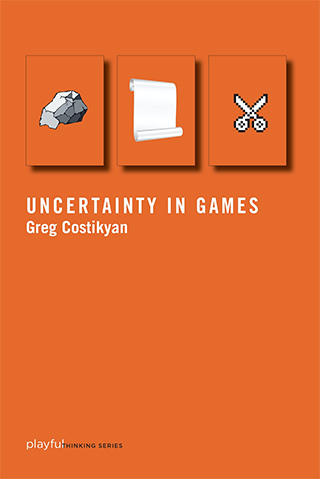The Psychological Depths of Rock-Paper-Scissors

Unless you have lived in a Skinner box from an early age, you know that the outcome of tic-tac-toe is utterly certain. At first glance, rock-paper-scissors appears almost as bad. A four-year-old might think there’s some strategy to it, but isn’t it basically random?
Indeed, people often turn to rock-paper-scissors as a way of making random, arbitrary decisions — choosing who’ll buy the first round of drinks, say. Yet there is no quantum-uncertainty collapse, no tumble of a die, no random number generator here; both players make a choice. Surely this is wholly nonrandom?

All right, nonrandom it is, but perhaps it’s arbitrary? There’s no predictable or even statistically calculable way of figuring out what an opponent will do next, so that one choice is as good as another, and outcomes will be distributed randomly over time — one-third in victory for one player, one-third to the opponent, one-third in a tie. Yes?
Players quickly learn that this is a guessing game and that your goal is to build a mental model of your opponent, to try to predict his actions. Yet a naïve player, once having realized this, will often conclude that the game is still arbitrary; you get into a sort of infinite loop. If he thinks such-and-so, then I should do this-and-that; but, on the other hand, if he can predict that I will reason thusly, he will instead do the-other-thing, so my response should be something else; but if we go for a third loop — assuming he can reason through the two loops I just did — then . . . and so on, ad infinitum. So it is back to being a purely arbitrary game. No?
No.
The reason rock-paper-scissors is not a purely arbitrary game, and the reason that an excellent player will win more often than chance would predict, is that human psychology is not random, and some behaviors are — not necessarily predictable, but likely to occur more often than chance would dictate.
A player who has studied the game will unquestionably win more than chance would dictate against a naïve player.
One heuristic of experienced players is “Losers lead with Rock.” This is demonstrably true; naïve players will lead with Rock more often than one-third of the time. Your hand begins in the form of a rock, and it is easiest to keep it that way. The name of the game begins with “Rock,” and if you are mentally sorting through the options, it is the first one that will occur to you. And the word “rock” itself has connotations of strength and immovability. These factors lead players to choose Rock on their first go more often than chance would dictate. An experienced player can take advantage of this. Against a player you know to be naïve, you play Paper.
Similarly, players rarely choose the same symbol three times in a row, and almost never four times; it feels wrong to human psychology. An extended streak feels nonrandom and unlikely, even though in a purely random game, each new throw is stochastic, not dependent on the outcomes of previous throws. Thus in a truly random game, no matter how many times “Paper” has come up in a row before, there is a 1 in 3 chance of it coming up again. Given the nature of human psychology, if Paper has come up twice, there is far less than a 1 in 3 chance that the player will choose it again.
Even players who know this have to consciously try to overcome their bias against streaks — particularly if they lose with one gesture on the previous round. If you have played Paper twice in a row, and lost the last time you played, the human instinct is to try something different, and thus players will at that point choose Paper far less than one-third of the time.
In short, a player who has studied the game will unquestionably win more than chance would dictate against a naïve player, because he understands how human psychology is likely to affect the choices of his opponent. Of course, two players who both understand these factors are on a more even plane; but even here, there is the factor of human readability. It is hard to maintain a perfect “poker face,” and some are better at it than others. Some are better at noticing subtle cues in the expressions or body language of others. These skills are not always sufficient to ensure triumph, but they do produce a bias in favor of those more observant — and more socially adept at reading others.
In other words, at first glance rock-paper-scissors appears to be a guessing game, with victory going to the player who can outguess his opponent; at second glance, it appears to be purely arbitrary; and at third glance, the original supposition is justified. It is, in fact, a guessing game with victory going to the player who can outguess his opponent, but there are strategies to “outguessing.”
Where is the uncertainty in rock-paper-scissors? That should be obvious. It is in the unpredictability of opposing players. In fact, that is all there is in rock-paper-scissors; a first-player shooter played in deathmatch mode may rely to some degree on player unpredictability, but it also relies on player performance. Rock-paper-scissors is a game of player unpredictability in its purest form, for this single factor is the sole determinant of the game’s uncertainty, its raison d’être, and its cultural continuance.
Greg Costikyan, an award-winning designer of board, tabletop, roleplaying, computer, online, mobile, and social games, and the author of several books, including “Uncertainty in Games,” from which this article is excerpted.



